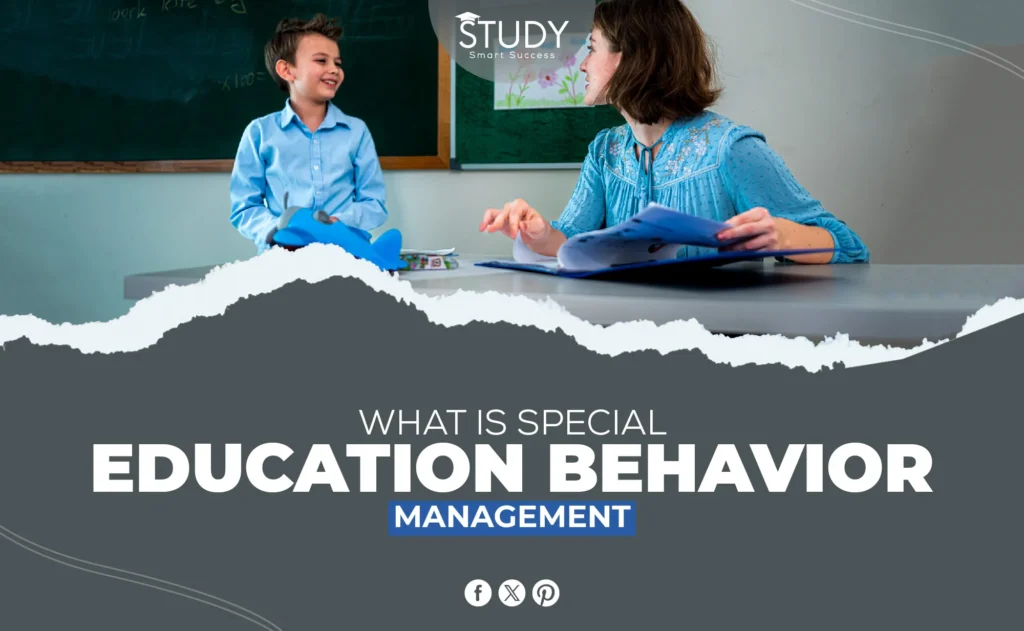Special education bridges the gap for disabled students by providing customized learning methodologies. This profession accommodates learning, mental, emotional, and physical challenges with standard teaching techniques. Special education is based on curriculum, instructional methods, and learning environment. Special education behavior management—a systematic approach to safe, accommodating, and supportive learning environments—is crucial. Read more about special education classroom must-haves.
Behavior Management
Positive behavior improvement is encouraged in special education behavior management. Through reinforcement and prevention, it promotes good behavior. All kids should be able to learn without interruptions.
Importance of Special Education Behavior Management
- Consistency Across Settings: Consistent behavior control tactics across several situations are critical for rewarding positive conduct. This encompasses settings such as classrooms, playgrounds, and the home. Consistency enables children to grasp expectations and establish habits that foster stability and confidence.
- Individualized Approaches: Consistent behavior control strategies across several settings are essential for rewarding positive behavior. This includes places such as classrooms, playgrounds, and homes. Consistency helps youngsters understand expectations and develop routines that promote stability and confidence.
- Positive Reinforcement: Positive reinforcement fosters the repetition of desired behaviors. This includes verbal praise, tokens, awards, and privileges encouraging students to follow anticipated behaviors and actively participate in their learning environment.
- Proactive Strategies: Using proactive techniques, such as clear instructions and regular feedback, can help prevent behavioral disorders. Anticipating probable issues and implementing preventive steps reduce interruptions and promote a helpful school environment.
- Collaborative Efforts: Behavior management benefits from a collaborative approach that includes instructors, support personnel, families, and, when appropriate, students themselves. Open communication and collaboration ensure that goals are aligned and support networks are strong.
- Continuous Monitoring and Adaptation: Regular assessment and customization of behavior management strategies are required to meet changing demands. Monitoring the success of initiatives enables rapid modifications, ensuring that students receive the most appropriate assistance for their growth.
Principles of Behavior Management
Several basic ideas underpin effective behavior management in special education, guiding educators in fostering a supportive and productive learning environment. These are the essential principles:
Consistency
Consistency is essential in behavior control. Consistently applying rules and punishments helps kids grasp what is expected of them. This dependability fosters a stable atmosphere in which all pupils can succeed.
Positive Reinforcement
Positive reinforcement entails praising a student’s positive conduct to encourage it to continue. This might include verbal praise, prizes, or privileges. Reinforcing positive conduct boosts a student’s self-esteem and drive, frequently leading to less undesirable actions.
Clear Expectations
Setting clear and reasonable expectations is critical. Students must understand what is expected of them and why certain actions are essential. These expectations should be expressed clearly and regularly and age—and developmental-appropriately.
Individualized Approach
Behavior management tactics should be customized to match the unique needs of each kid. What works for one kid may not work for another. Therefore, educators must regularly examine the success of their tactics and make adjustments as needed.
Preventive Measures
Preventive techniques entail recognizing and treating possible behavioural triggers before they lead to undesirable behaviour. This might involve modifying the learning environment, altering the routine, or implementing particular interventions targeted to the student’s requirements.
Data-Driven Decisions
It is critical to use data to guide behavior management decisions. This entails regularly gathering and evaluating student behaviour data and adopting effective tactics. This study enables educators to judge which tactics to maintain, change, or discontinue.
These concepts are the foundation for a successful behavior management system, ensuring the educational environment meets all students’ learning and social requirements. By creating a pleasant and inclusive environment, educators can help students develop and succeed more effectively.
Common Behavioral Challenges in Special Education
Behavioral issues in special education might vary greatly, but common patterns can appear across diverse contexts. Recognizing these typical difficulties allows educators to develop more effective management solutions. The following are some of the most often encountered behavioral challenges:
Aggression
Students’ aggression might emerge as both physical and verbal outbursts. It is frequently a reaction to irritation, sensory overload, or a failure to convey requirements effectively. Aggression management necessitates a thorough review of triggers and regular measures to assist children in developing more appropriate stress responses.
Non-compliance
Noncompliance or failure to follow orders can disrupt the learning environment and create substantial issues for classroom management. This conduct might result from a lack of knowledge, differing expectations, or an aversion to scheduled activity.
Inattention
Students struggling with attention may struggle to stay focused on things for long periods. This might result in unfinished assignments and learning gaps if not addressed effectively. Breaks, hands-on learning activities, and the use of assistive technology are all potential strategies.
Social Withdrawal
Some students may avoid talking to adults or other students, hurting their social and mental growth. This withdrawal could be caused by stress, sadness, or a dislike of being around other people. Getting involved early can help them deal with these problems and improve their health.
Disruptive Behavior
Distracting behaviors, like yelling, talking over other people, or moving around incorrectly, can make it harder for the person and their peers to learn. These actions could be efforts to avoid hard jobs or get the attention of teachers or classmates. Dealing with these habits right away can improve everyone’s learning setting.
Emotional Outbursts
Students who struggle to regulate their emotions are likelier to experience emotional outbursts, such as sobbing, laughing, or yelling excessively. Such outbursts may disturb the learning environment and require specialized interventions to assist the learner in regaining emotional control. Teachers and caregivers are important in helping pupils acquire these critical abilities.
Addressing these behaviors frequently requires a combination of personalized support programs, environmental modifications, and coordination with parents, counselors, and other experts. Understanding these typical obstacles allows educators to better prepare for their student’s needs and promote a helpful learning environment.
Strategies for Effective Behavior Management
Implementing effective behavior management methods in special education is critical for addressing varied behavioral difficulties and improving learning results. Here are some important techniques that instructors may implement:
Individual Behavior Plans
Creating tailored behavior programs is critical for meeting unique requirements. These plans often include explicit targets, personalized treatments, and techniques that address the student’s specific issues. They also specify how progress will be monitored and the criteria for success.
Positive Behavior Support (PBS)
Positive Behavior Support (PBS) is a proactive method that teaches and reinforces positive behaviors as alternatives to problematic ones. PBS practices are used throughout the school, fostering a consistent and supportive approach to behavior control. This promotes a more inclusive and effective learning environment for all students.
Structured Learning Environment
Creating an organized learning environment may greatly lessen behavioral concerns. This includes:
- Properly structuring physical places.
- Maintaining regular routines.
- Enforcing clear standards that all pupils understand.
A well-structured setting reduces anxiety and confusion among pupils.
Visual Supports
Visual aids such as charts, photos, and signs can help students understand expectations and procedures. They are especially useful for kids who struggle with verbal instructions or have concentration issues. Visual aids are also a continuous reference point that students may quickly access.
Communication Strategies
Improving communication skills is essential for effective behavior management. This may involve using alternative and augmentative communication (AAC) technologies for nonverbal pupils with difficulty speaking. Effective communication reduces irritation and misunderstandings, which can contribute to behavioral disorders.
Collaborative Team Approach
A collaborative team of experts, including teachers, behavior specialists, therapists, and family members, may give a holistic approach to behavior control. Collaboration guarantees that all student well-being areas are addressed and supported.
Ongoing Monitoring and Feedback
It is critical to monitor behavior regularly and use behavior control measures. Feedback should be constructive and constant, allowing for revisions to techniques as necessary to better meet the student’s requirements. Collaboration with parents and other educators can significantly increase the efficacy of these initiatives.
Integrating these tactics allows educators to create a more inclusive and supportive school environment that meets the different needs of kids with behavioral issues. Effective behavior management improves classroom dynamics and the educational experience for all students.
Tools and Resources for Educators
Educators can use various methods and resources to regulate behavior in special education settings effectively. These tools are intended to help implement behavior management tactics, making the process more manageable and successful. Here’s a list of some key tools and resources:
Behavioral Tracking Apps
- ClassDojo: A popular classroom management software that lets instructors assess student achievement and conduct and provides students and parents with real-time feedback. It promotes excellent conduct, teacher-parent communication, and a happy learning environment.
- PBIS Rewards: A PBIS-based system for measuring and rewarding positive behavior. It manages incentives, recognizes student successes, and collects data to assist schools in adopting PBIS and creating a positive school atmosphere.
Educational Software
- GoNoodle: Provides dancing, mindfulness, and physical movement techniques to control classroom energy and increase concentration. These exercises captivate pupils and may be readily introduced into regular routines to promote brain breaks and physical activity.
- BrainPOP: BrainPOP offers animated teaching information in numerous disciplines to engage pupils and explain behavior standards. Its huge library of videos, quizzes, and games makes hard topics interesting and accessible, allowing students to explore and learn at their own speed.
Professional Development Workshops
- Behavior management, crisis intervention, and classroom management workshops are essential for teacher education. They prepare teachers for different classroom dynamics and difficult scenarios, making learning enjoyable and productive for all pupils.
- Numerous educational service agencies and special education organizations provide sessions designed specifically for special educators. These sessions offer targeted training and resources to meet the specific needs of students with disabilities, promoting an inclusive and supportive educational environment.
Online Forums and Support Networks
- Council for Exceptional Children (CEC): This organization provides many resources, such as professional development courses, webinars, and publications. It cultivates a community for special education professionals dedicated to enhancing the success of children with exceptionalities.
- Teachers Pay Teachers: Offers a comprehensive marketplace of behavior management plans and educational resources developed by seasoned educators. These resources can be customized to meet various classroom requirements, assisting educators in creating effective learning environments.
Books and Literature
- “Lost at School” by Dr. Ross W. Greene: Emphasizes collaborative and proactive approaches to behavior management. The text highlights the importance of comprehending the fundamental causes of difficult behaviors. This work offers effective strategies to promote positive changes in students and educational settings.
- “The Behavior Code” by Jessica Minahan and Nancy Rappaport, MD: This book provides approaches for comprehending and managing difficult behaviors in educational settings. It emphasizes the significance of customizing interventions to meet individual needs. The authors present insights and case studies to assist educators in effectively managing behavioral issues.
Training in Behavioral Intervention Techniques
Behavior analysis and crisis intervention certifications help instructors address difficult behaviors. Crisis Prevention Institute programs promote safe and effective methods. Teacher empowerment initiatives help establish a supportive learning environment for all students.
Visual Aid Tools
Boardmaker and Canva can help design personalized timetables, rules, and reminders for non-verbal communication and routines. These technologies improve visual aid users’ comprehension.
These materials help instructors improve their behavior management abilities and meet students’ educational and behavioral requirements. Teachers may create a more inclusive, productive, and supportive learning environment by incorporating these into everyday routines and techniques.
Conclusion
Behavior management is crucial in special education. Educators may improve special education by regulating misbehavior and creating a stable, supportive learning environment. The guidelines stress consistency, comprehension, and proactive actions to promote academic performance and social integration.
Educators must continue studying and adopting new behavior control methods as special education evolves. Stay current on research, tools, and strategies to improve student assistance. Collaboration with educators, experts, and families can also improve behavior control.
The objective is to give all kids the tools and assistance they need to succeed in and out of school. By continuing to educate and adapt, educators can guarantee their kids’ best outcomes and prepare them for a brighter, more inclusive future.


